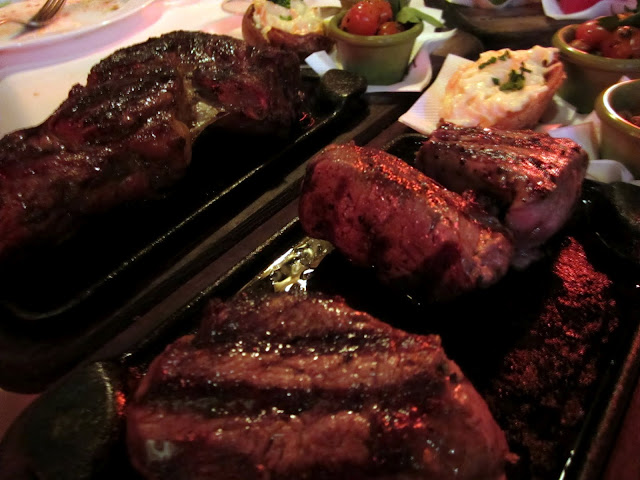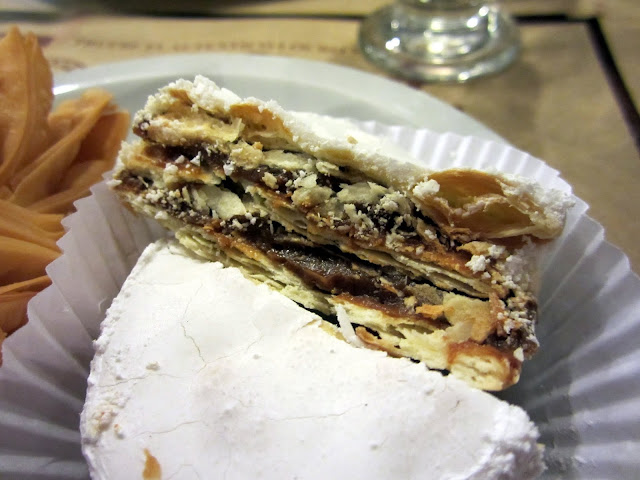Our first stop is Don Julio (Guatemala 4691), which is an upper crust steakhouse in the Palmero district. The steak here is fantastic and the vibe of the entire restaurant is very much old school. We got in at 8pm, which is early by Argentine standards, and ended up with lomo (tenderloin) which is pictured above. The cut is generous and the beef itself is phenomenal. This steak paired with a malbec is what makes restaurants like this famous. Reservations here are strongly recommended.
Steak may be well known, but it is certainly not the only traditional food for the city. With a strong Italian cultural influence, pizza and pasta are staples of the food culture here. For our pizza fix, we tried El Cuartito (Talcahuano 937) which has been serving up pizza since 1934.
This is a well loved spot full of locals. The walls are covered with sports memorabilia from a mix of sports (including a poster of Michael Jordan playing for the Bulls). Overall, a no-nonsense welcoming pizzeria. We were a little out of place as tourists, but united by our love of pizza and beer. This pizza pie was a bit different from a lot of pizzas, with uniformly thick crust underneath all of the toppings and green olives as a mandatory topping. After nearly 80 years, they have this down to a science and both of the pizzas were delicious. The crust was just substantial and crispy enough, with just the right amount of cheese, and great flavors. My favorite was the Atomica, seen below with the tabasco sauce on it.
Want to see more of the restaurant scene in Buenos Aires, along with what has to be the all time, best treat from Argentina? Keep reading after the break!
Pizza isn't the only Italian that is being served here. Our next restaurant takes us towards "La Boca", where the famed (if overrated) Caminito is. Il Mattarello is full of families and friends meeting over a hearty meal of pasta, salad, and wine. If you are not looking out of it and if you are not seeking it out explicitly, odds are you will never stumble across this restaurant tucked away on the ground floor of a residential street (Martín Rodríguez 517).
The pasta here is all hand made and rustic, with hearty flavors and plenty of cheese. Prices were reasonable for what you get and the quality of the food. A reservation can be a good idea, since the place fills up quickly.
No list of restaurants in Buenos Aires can be complete without the next entry: La Caberra. This is one of the most well known steakhouses in the city and sure to be a great time with a reservation. The steak was on par with Don Julio, but for us the meal was a little more festive. That might have had something to do with the free bottles of wine that they gave us at the end, or the fact that we had an unexpected visit in the spirit of the Ameglian Major Cow (Hitchhiker's Guide to the Galaxy reference. Google it.)
But what about the steak? Gargantuan and delicious. By US standards, this is like getting half off steak at one of the best places in town. There is plenty of debate whether La Caberra is the best steakhouse in town, but the fact is this is a memorable and fantastic meal.
Finally, the biggest, best, amazing treat from Argentina that I promised? Alfajores. These are everywhere, from the gas station (where we first encountered them in Uruguay) to upscale restaurants. The Alfajor is one of best treats in the region and instantly won us over. They are round, small cookie sandwiches (seen here below on the right) that combine cookie, dulce de leche, and a coating of deliciousness to top it off.
The most famous alfajores in Buenos Aires come from Havanna, which runs a series of shops and coffee shops around town. They come in a variety of flavors, including one with chocolate, lemon, and hazelnut, and every one of them is delicious. They are somewhere similar to moon pies, but with the marshmallow swapped out for rich dulce de leche filling. They can be purchased in the US, but these are fairly hard to come by. Our biggest mistake of the trip was not buying more of these to bring home, because everyone one that we have shared them with have been blown away by these simple, small treats.
Outside the style that Havanna offers, another variant is common in the cafes around Buenoes Aires. These alfajores have the dulce de leche between two shortbread cookies, rolled in coconut around the edges. The example below comes from El Gato Negro, which is one of the traditional cafes in Buenos Aires. If you visit South America, keep an eye out for anything that looks like these. They come in flavors ranging from these traditional styles to Oreo Alfajores, but all of them are delicious.
Next time? More food from Buenos Aires.






























No comments:
Post a Comment